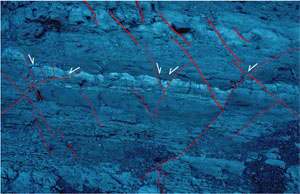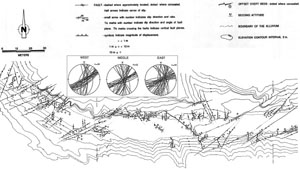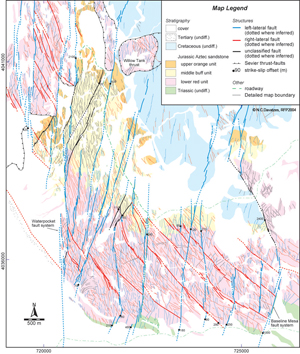| |||||||
|
|
|||||||
|
|
|||||||
| Multiple Strike-slip Fault Sets | |||||||
|
In small scale, strike-slip fault patterns in map view (Figure 1) are quite similar to the simple normal fault patterns in cross section described under 'Multiple Normal Fault Sets.' Basically two sets of strike-slip faults with opposing sense of slip form a fault pattern with dihedral intersection angle. In terms of the Andersonian approach, the bisector of this angle is commonly interpreted to be the direction of the greatest compression, and the line of intersection of the two planar sets contains the direction of the intermediate principal stress. Figure 2 is a plane-table map showing fault pattern in sedimentary rocks cropping out along a wash adjacent to the eastern end of the Las Vegas Valley Shear Zone in the Lake Mead area. Although the base of the wash has been locally covered and the shoulders of the wash have steep topography, the map pattern, detailed kinematic observations, and the stero plots show right- and left-lateral strike-slip faults with a reasonable consistency. Figure 2 is a seismic data set showing a horizon (the top of a reservoir rock in the Middle East) with two sets of faults interpreted to be right- and left-lateral strike-slip faults. The slip magnitudes are small (on the order of a few tens of meters) but the lateral extent of the faults are surprisingly large (tens of kilometers). The individual fault traces on the horizon are discontinuous and the stepovers between the neighboring segments have signatures either structurally low or high. As will be revisited in the section under 'Fault Segment Linkage,' this allows us to infer the sense of slip along the segments. This information also reveals that there must be other structures at the stepovers along the faults in Figure 2 but they could not be detected due to the resolution of the seismic data. Figure 3 is a map of a portion of Valley of Fire State Park (NV). The map shows well-developed left (blue lines)- and right (red lines)-lateral strike-slip fault sets. In a few places there are faults which diverge from these orientations (black lines). Excluding these small number of non-systematic faults, the pattern appears to be a typical conjugate pattern. Under 'Mechanism and Mechanics of Multiple Strike-slip Fault Sets,' it will be shown that this pattern formed by shearing of joint, splay fracturing, and subsequent shearing of the splay fractures. We should just keep in mind that faults form by various mechanisms and that these mechanisms are dictated by the rheology of the faulted rock. There are, of course, larger scale strike-slip faults forming transform plate boundaries. These almost always have other types of attendant faults, and therefore, will be presented under 'Assemblages of Different Types of Faults.' | |||||||
| Reference: |
|||||||
| Aydin, A., Page, B.M., 1984 Cakir, M., Aydin, A., 1994 Flodin, E.A., Aydin, A., 2004 Johnson, C.A., Hauge, T., Al-Menhali, S., Bin Sumaidaa, S., Sabin, B., West, B., 2005 |
|||||||
|
Readme | About Us | Acknowledgement | How to Cite | Terms of Use | Ⓒ Rock Fracture Knowledgebase |
|||||||


